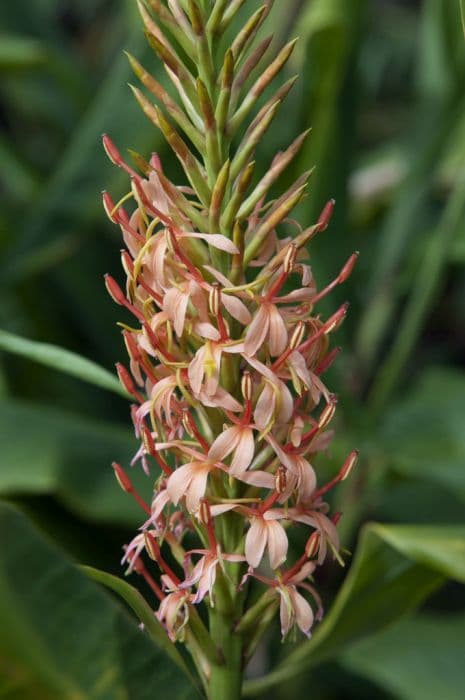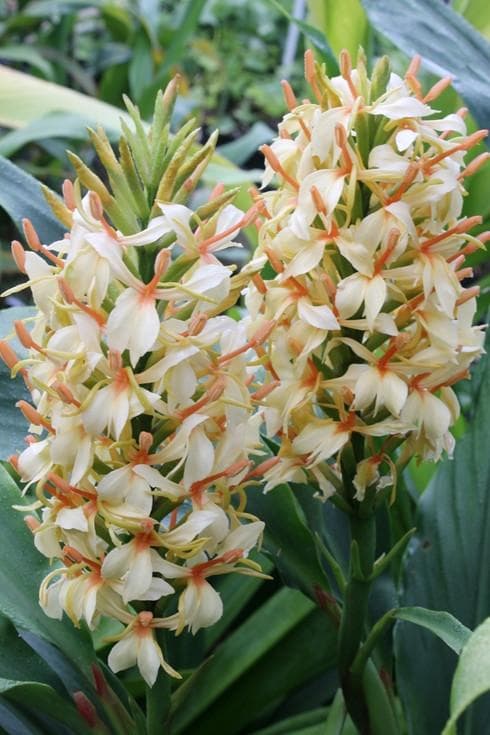Ginger lily Hedychium densiflorum

ABOUT
Hedychium densiflorum, commonly known as the ginger lily, is a visually striking plant known for its vibrant and ornamental flowers. The ginger lily is characterized by lush green foliage which forms a dense cluster. The leaves are elongated, with a glossy surface and a sharp pointed tip, adding to its tropical appeal. The most notable feature of the ginger lily is its spectacular inflorescence. The flowers are densely packed on a cone-like structure that emerges from the foliage. These blossoms come in bright shades of yellow, orange, or red, depending on the variety, creating a bold contrast against the green leaves. Each individual flower is quite intricate, with delicate petals that may have a slight curl at the edges. As the flowers bloom successively from the base of the cone to the tip over time, this flowering feature provides a long-lasting display of color. The inflorescences are not only a feast for the eyes but also emit a delightful fragrance that can perfume the surrounding area, making it a popular choice for gardens and landscapes where a sensory impact is desired. After the flowering season, the ginger lily may produce seed capsules, which upon maturing, can split open to release seeds. This allows for the propagation and spread of the ginger lily in suitable growing conditions. The overall aesthetic of the ginger lily with its rich floral displays and lush foliage offers a tropical ambiance and is often used in garden borders, as specimen plants, or in containers.
About this plant
 Names
NamesSynonyms
Ginger Lily, Dense-Flowering Ginger
Common names
Hedychium spicatum var. acuminatum, Hedychium acuminatum.
 Toxicity
ToxicityTo humans
The Ginger Lily is not widely known to be toxic to humans. There is limited information on severe adverse effects from ingestion, and it is often grown in gardens without any particular concern for human toxicity. However, as with any plant, individual allergies or sensitivities can occur. If a person were to ingest a part of the Ginger Lily and experience symptoms such as stomach upset, it's advisable to consult a healthcare provider.
To pets
The Ginger Lily is not typically listed as a toxic plant to pets, such as dogs and cats. There is not much scientific documentation concerning its toxicity to household pets. However, caution should be exercised as individual pets might have sensitivities or allergic reactions. If a pet ingests part of the Ginger Lily and shows signs of distress or illness, a veterinarian should be consulted promptly. Symptoms to watch for typically include vomiting, diarrhea, or drooling, which are common indicators of plant toxicity in pets.
 Characteristics
CharacteristicsLife cycle
Perennials
Foliage type
Deciduous
Color of leaves
Green
Flower color
Orange
Height
4-6 feet (1.2-1.8 meters)
Spread
2-3 feet (0.6-0.9 meters)
Plant type
Herb
Hardiness zones
7
Native area
Himalayas
Benefits
 General Benefits
General Benefits- Ornamental appeal: Hedychium densiflorum, commonly known as ginger lily, adds aesthetic value to gardens and landscapes with its attractive foliage and striking floral displays.
- Attracts pollinators: The plant's brightly colored flowers are known to attract pollinators such as bees, butterflies, and hummingbirds, supporting local ecosystems.
- Fragrance: Ginger lily flowers emit a pleasant fragrance that can enhance the sensory experience of a garden or outdoor space.
- Easy to grow: This plant is relatively easy to cultivate and can thrive in a variety of soil types, requiring minimal maintenance once established.
- Shade tolerance: Ginger lily can grow in partial shade, providing gardeners with a versatile option for planting in less sunny areas.
 Medical Properties
Medical Properties- Anti-inflammatory: Hedychium densiflorum may contain compounds that help reduce inflammation.
- Analgesic: There may be elements in the plant that are used to alleviate pain.
- Antipyretic: The plant could be used to reduce fever.
- Antimicrobial: It might have the capability to inhibit the growth of certain bacteria and fungi.
- Antioxidant: Hedychium densiflorum could possess antioxidants that help in protecting cells from damage caused by free radicals.
 Air-purifying Qualities
Air-purifying QualitiesThis plant is not specifically known for air purifying qualities.
 Other Uses
Other Uses- The ginger lily's fragrant flowers can be used in potpourri blends to add a pleasant scent to your home.
- The roots of the ginger lily can be macerated and used in natural insect repellent formulations.
- Fresh or dried ginger lily flowers can be incorporated into floral arrangements for their aesthetic appeal and fragrance.
- The pulp made from ginger lily roots can sometimes be used as a natural dye for textiles, giving a soft yellow to tan color.
- Ginger lily can be planted as a natural privacy screen due to its dense foliage.
- The stalks and fibers of the ginger lily can be used in crafting traditional decorative items such as wreaths and bouquets.
- Ginger lily is used in horticulture as a plant for teaching and demonstrating plant division and propagation techniques.
- The essential oils extracted from ginger lily flowers are used in homemade perfumes and scented candles.
- Leaves of the ginger lily can be used to wrap food items, adding flavor and an aromatic twist to the cuisine.
- In some cultures, ginger lily is considered a symbol of good fortune and is included in rituals and festive decorations.
Interesting Facts
 Feng Shui
Feng ShuiThe Ginger Lily is not used in Feng Shui practice.
 Zodiac Sign Compitability
Zodiac Sign CompitabilityThe Ginger Lily is not used in astrology practice.
 Plant Symbolism
Plant Symbolism- Tropical Beauty: Due to its origins in the Himalayas and India, Hedychium densiflorum, commonly known as ginger lily, often symbolizes exotic beauty and a unique charm akin to the allure of tropical regions.
- Inviting Fragrance: Ginger lilies are known for their sweet and intense fragrance. As such, they symbolize the power of attraction and the idea of inviting positive influences into one's life.
- Prosperity and Abundance: In some cultures, flowering plants like the ginger lily are associated with prosperity and abundance. The full, lush blooms can be seen as a sign of wealth and richness.
- Versatility: The ginger lily has uses in both ornamental and medicinal practices. This multifunctional aspect gives it a symbolism for versatility and adaptability.
 Water
WaterThe Ginger Lily, or Hedychium densiflorum, prefers consistent moisture and should be watered thoroughly whenever the top inch of soil feels dry to the touch. During the growing season in the spring and summer, this can mean watering once or twice a week, but always check soil moisture before watering. It is important not to let the plant sit in water, so ensure proper drainage. Typically, a Ginger Lily planted in a garden setting might need about 1 to 1.5 gallons of water per week, but this can vary depending on climate conditions. During winter, reduce watering to allow the soil to dry out more between applications.
 Light
LightGinger Lily thrives in partial shade to bright, indirect sunlight. It should be placed in a location where it receives dappled sunlight throughout the day or bright light without the harshness of direct midday sun. Avoid deep shade as it can hinder the plant's flowering potential.
 Temperature
TemperatureGinger Lily does well in temperatures ranging from 60°F to 85°F, which are common in its natural habitat. It can survive minimum temperatures down to about 50°F but should be protected from frost. To encourage flowering, maintain the ideal temperature around 70°F to 80°F during the growing season.
 Pruning
PruningPruning Ginger Lily involves removing spent flowers to encourage new growth and additional blooms. Cut back the plant after flowering or in early spring to manage its size and shape, and to stimulate healthy new shoots. Pruning is typically done annually, but it may vary depending on the plant's performance and desired appearance.
 Cleaning
CleaningAs needed
 Soil
SoilGinger lily thrives in rich, well-draining soil with high organic matter. A mix containing equal parts of loam, peat, and perlite or sand works well. The ideal soil pH for ginger lily is slightly acidic to neutral, ranging from 6.1 to 6.5.
 Repotting
RepottingGinger lilies should be repotted every 2-3 years to refresh the soil and accommodate growth. It is best done in spring before new growth starts.
 Humidity & Misting
Humidity & MistingGinger lily requires high humidity to thrive, generally above 60%. It mimics its natural humid tropical habitat.
 Suitable locations
Suitable locationsIndoor
Place in bright, indirect light and ensure high humidity.
Outdoor
Plant in partial shade, protect from wind, and ensure soil drainage.
Hardiness zone
7-10 USDA
 Life cycle
Life cycleGinger Lily (Hedychium densiflorum) begins its life cycle as a rhizome, a horizontal underground stem that stores energy and nutrients. In the spring, shoots emerge from the rhizomes, leading to the development of stems and lance-shaped leaves. Throughout the summer, the Ginger Lily produces dense spikes of fragrant orange or yellow flowers that attract pollinators. After pollination, these flowers develop into seed capsules. Once mature, the seeds disperse, and if they land in a suitable environment, they germinate and develop new rhizomes. The plant then enters a period of dormancy during the colder months, where it conserves energy in its rhizomes to survive until the next growing season.
 Propogation
PropogationPropogation time
Spring-Early Summer
The most popular method of propagation for the Ginger Lily (Hedychium densiflorum) is by division of its rhizomes. This process is best done in late winter or early spring before new growth begins. To propagate by division, carefully dig up the clump of rhizomes and gently separate them, making sure each division has at least one growth bud. These divided pieces can then be replanted into well-draining soil at a depth of approximately 2 to 3 inches (5 to 7.6 centimeters), spaced around 16 to 24 inches (40 to 60 centimeters) apart to allow room for growth. Water the new plantings well and maintain consistent moisture as the Ginger Lily establishes itself.








